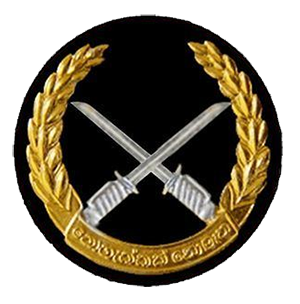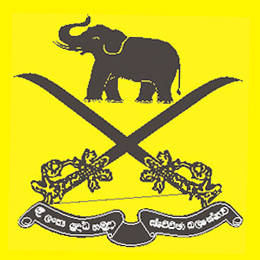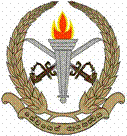The Ceylon Defence Force (CDF) was established in 1910 by the Ceylonese legislation Ceylon Defence Force Ordinance, which reformed the Ceylon Volunteer Force (CVF) that existed previously as the military reserve in the British Crown colony of Ceylon. At the time of forming it was only a reserve force but soon developed into a regular force responsible for the defence of Ceylon. The CDF was under the command of the General Officer Commanding, Ceylon of the British Army in Ceylon if mobilised. However mobilisation could be carried out only under orders from the Governor.

Lieutenant General Denzil Lakshman Kobbekaduwa, RWP, RSP, VSV, USP was a senior Sri Lankan Army officer who served in the 1971 Insurrection and the Sri Lankan Civil War.

The Sri Lanka Army is the oldest and largest of the Sri Lanka Armed Forces. The army was officialy established as the Ceylon Army in 1949, though the army traces it's roots back in 1881 when Ceylon Light Infantry Volunteers was created; the army was renamed as the 'Sri Lanka Army' when Sri Lanka became a republic in 1972. In 2024, the Army had approximately 150,000 personnel.

The Commando Regiment is the commando formation of the Sri Lanka Army. The unit specializes in various roles including hostage rescue, counter-terrorism, unconventional warfare, special reconnaissance, counter-insurgency, and personnel recovery. It was formed in 1980 and is based in Ganemulla, a suburb of Colombo.

The Sri Lanka Armoured Corps (SLAC) provides the armour capability of the Sri Lanka Army, with vehicles such as the T-55AM2, and type 80/88 main battle tanks; the BMP infantry fighting vehicle; and the BTR-80, and WZ551 armoured personnel carriers. It comprises five regular armoured regiments, a volunteer regiment, and a regimental band. It has an independent Armoured Brigade and is headquartered at Rock House Army Camp, Colombo.
The National Cadet Corps (NCC) is a youth organisation in Sri Lanka, sponsored by the Ministry of Defence, which operates in schools, and normally includes Army, Navy and Air Force sections. The corp is open for secondary school students on voluntary basis and its officers are government teachers and educational administrators, who serve as instructors. The Cadets are given basic military training in small arms and parades, as well as leadership training.

The Sri Lanka Army Volunteer Force (SLAVF) is the active-duty volunteer reserve force of the Sri Lanka Army. The SLAVF is separate from the Regular Force which consists of personal who are professional soldiers and its Regular Reserve, which comprises personal who have a mobilization obligation following their service in the regular army. The SLAVF consists of the volunteer force and the volunteer reserve; administration and recruitment of reserve personal is carried out by the Volunteer Force Headquarters in Shalawa, Kosgama which is headed by the Commandant of the Volunteer Force. It has a current strength of about 55,000 personnel. The SLAVF was known as the Ceylon Volunteer Force from 1949 to 1972 and the Sri Lanka Volunteer Force from 1972 to 1985.

The Sri Lanka Army Medical Corps (SLAMC) (Sinhala: ශ්රී ලංකා යුද හමුදා වෛද්ය බලකාය Shri Lanka Yuddha Hamuda Vayidya Balakaya) is a specialist corps in the Sri Lanka Army which specializes in military medicine and provides medical services to all army personnel and their families in war and in peace. It is made up of 4 regular units and one volunteer unit. Headquartered in Colombo, formally at army headquarters. The corps Cap badge depicting the Rod of Asclepius. General officers and senior officers of the SLMC wear gorget patches of maroon rather than of scarlet worn by other officers of similar rank.

The Sri Lanka Military Academy, commonly known simply as Diyatalawa, is the oldest military academy in Sri Lanka, and trains commissioned officers for the Sri Lanka Army. It is located in the garrison town of Diyatalawa in the central highlands of Sri Lanka. It has capacity to train more than 300 cadets.

General Deshamanya Joseph Everard Denis Perera, VSV, FCMI was a senior Sri Lanka Army general who served as Commander of the Sri Lankan Army from 1977 to 1981. He was also the Sri Lankan High Commissioner to Australia, Chairman of the Securities and Exchange Commission and the Ceylon Tobacco Company and Chancellor of General Sir John Kotelawala Defence University. He envisioned for a women's corps in the army which resulted in the creation of the Sri Lanka Army Women's Corps in 1979.
The Diyatalawa Garrison is a common name used for collection of military bases of the Sri Lanka Army located in and around the garrison town Diyatalawa in the Uva Province. Sometimes it is referred to as the Diyatalawa Cantonment. It is one of the oldest military garrisons in Sri Lanka. It is home to the several training centers of the army, including the Sri Lanka Military Academy and has a detachment of the Gemunu Watch. The Sri Lanka Army Medical Corps maintains a base hospital in Diyatalawa. SLAF Diyatalawa is situated in close proximity.
General Shantha H.S. Kottegoda, WWV, RWP, RSP, VSV, USP is a retired senior Sri Lanka Army general. He was the seventeenth commander of the Sri Lankan Army from 1 July 2004 – 5 December 2005. He had served as the Sri Lankan Ambassador to Brazil and Thailand. In April 2019, following the Easter Sunday bombings he was appointed as the permanent secretary to the Ministry of Defence.
Major General C.H. Fernando, VSV was a senior Sri Lanka Army general, who was the former Director of Operations, General Staff; GOC, 2 Division; Commander, Northern Command.
Major General T. N. De Silva, USP is a former Sri Lanka Army general, who was the former General Officer Commanding, 21 Division;, Commandant, Sri Lanka Army Volunteer Force, Brigade Commander Armoured Brigade and Director, National Cadet Corps.
Major General Devinda Kalupahana, RSP, USP, psc, SLAC was a Sri Lankan army general, who was the former GOC, 3 Division; GOC, 2 Division; Director Operations, General Staff and Commandant, Sri Lanka Military Academy.
Major General Y. Balaretnarajah, VSV, USP, ndc is a retired Sri Lankan army officer. He had served as Chief of Staff of the Sri Lanka Army, Commandant of the Volunteer Force and Commander - Jaffna Security Forces. He has commanded the 1 Division, Armoured Brigade, 21 Brigade and 24 Brigade.

General Lionel Piyananda Balagalle,, was a senior Sri Lanka Army officer, who served as the Commander of the Sri Lanka Army and the Chief of the Defence Staff. He is known for formalising military intelligence operations within the Sri Lanka Army, having founded the Directorate of Military Intelligence and the Military Intelligence Corps.
The Sri Lankan Armed Forces have established numerous academies and staff colleges across Sri Lanka for the purpose of training professional soldiers in military sciences, warfare command and strategy, and associated technologies.
Brigadier Leonard "Lyn" Merlyn Wickramasuriya was a Sri Lanka Army officer, he served as the Commandant, Army Training Centre and Diyatalawa Garrison Commander.
Major General Duleep Justin De Sliva Wickramanayake was a general of the Sri Lanka Army. He served as the Director Operations and Training of the Sri Lanka Army.








